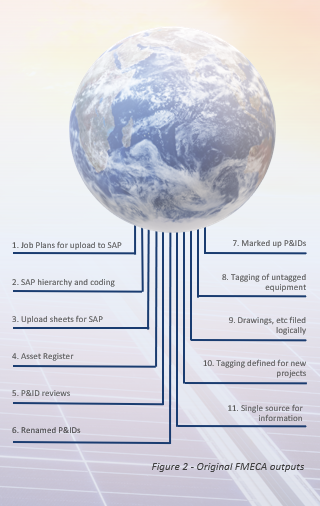FMECA - A Strategic Tool
FMECA: A Strategic Tool for Smarter Maintenance
Modern businesses depend on reliable assets to deliver consistent results — but reliability doesn’t happen by chance. It takes foresight, structured analysis, and the right tools to keep operations running smoothly and efficiently. One such tool, often overlooked yet incredibly powerful, is FMECA: Failure Modes, Effects, and Criticality Analysis.
More than just an acronym, FMECA is a practical methodology that helps organisations anticipate where things might go wrong — and take action before they do. Whether you're managing a fleet of machines, a network of utilities, or a complex production line, FMECA gives you the insight needed to prioritise risks, plan smarter maintenance, and ultimately, avoid costly surprises.
What is FMECA?
FMECA is a step-by-step process that identifies all the ways a system or component could potentially fail. But it doesn’t stop there - it goes further to assess how serious each failure might be, how likely it is to occur, and how easily it could be detected. By weighing these factors, you can rank the most critical issues and tackle them before they cause disruptions.
Think of it as a risk filter: it helps you separate minor irritations from major threats, so you can focus your time and resources where they’ll make the biggest impact.
Why FMECA Matters to Asset-Intensive Businesses
If your organisation depends on complex equipment or infrastructure, the consequences of a breakdown can be severe — from safety hazards and production delays to lost revenue and damaged reputations.
FMECA helps you stay ahead of these risks by:
Preventing breakdowns through early identification of weak points
Targeting your maintenance efforts where they’re most needed
Improving safety by analysing the consequences of failure
Reducing costs by avoiding reactive maintenance and emergency fixes
Supporting compliance in regulated industries where documentation and risk mitigation are essential
In essence, FMECA gives you confidence that you're doing the right things to keep your operations running smoothly.
How FMECA Fits Within Reliability-Centred Maintenance (RCM)
FMECA is often used as a core part of Reliability-Centred Maintenance (RCM). While RCM is the overall framework that helps define what maintenance your assets actually need, FMECA is the tool that helps you identify what could fail — and how bad the consequences would be if it did.
RCM asks:
What are the functions of the asset?
What would happen if it failed?
How can we prevent that?
FMECA provides the answers through a structured analysis of failure modes, effects, and criticality. Together, RCM and FMECA form a powerful approach to optimising asset performance and lifespan.
How the FMECA Process Works
You don’t need to be a reliability engineer to get value from FMECA. Here’s how the process usually unfolds:
Define the system or process
Start with a clear boundary — what exactly are you analysing?
List potential failure modes
For each component or step, ask: how could this fail?
Identify effects of each failure
What would happen if it did fail? Would it stop production? Create a safety risk?
Assess severity, likelihood, and detectability
This helps you calculate a criticality score (often a Risk Priority Number or RPN).
Prioritise and act
Focus your improvement or maintenance plans on the most critical issues.
Document and review
Like any good strategy, FMECA should evolve over time. Regular reviews keep it relevant.
Real-World Example: From Reactive to Reliable
At MCP, we worked with a large energy and utilities provider who faced issues with an incomplete asset register, inconsistent maintenance routines, and minimal planning structure.
Using FMECA, we helped them:
Map their assets clearly and consistently
Introduce structured job planning and scheduling
Standardise maintenance activities across teams
Improve control over drawings and documentation
The outcome? Less reactive firefighting. More proactive decision-making. And a smoother path to sustainable improvement.
Why FMECA is Worth Your Time
In the rush of day-to-day operations, it’s tempting to stick with what’s always been done. But tools like FMECA offer a chance to step back, ask smart questions, and make informed changes that lead to real improvement.
If you’re looking to reduce downtime, manage risk more effectively, or just get a better handle on your maintenance strategy, FMECA is a great place to start.
Whether you're just getting started with FMECA or have already begun and run into unexpected challenges, we're here to help. Simply get in touch with us and a member of our team will be in touch to support you on your journey.



